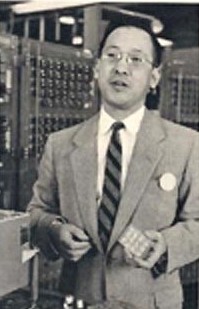-
(b.) -1918(d.)2001
Bio/Description
A Chinese-born American missile guidance scientist and a digital computer pioneer, he was born in Taiyuan, Shanxi Province, China, near the Mongolian border in 1918. He received a B.S. degree in Electrical Engineering from National Chiao Tung University (now Shanghai Jiao Tong University) in 1940; and in 1942 he earned an M.S. degree in Electrical Engineering from the Massachusetts Institute of Technology (MIT) in Cambridge, Massachusetts. His master?s thesis, titled, ?The Study of Selsyn Machines? dealt with what are commonly called closed-loop control systems or servomechanisms. As a natural extension of the latter, General Electric employed him during World War II to redesign anti-aircraft fire control systems based on intelligence about the Japanese Zero. While working for the Arma Division of the American Bosch Arma Corporation during the 1950s, he pioneered the use of digital computers in missile, satellite and spacecraft guidance systems, leading the design of the United States Air Force Atlas E/F ICBM (Inter-Continental Ballistic Missile) all-inertial guidance system and guidance computer, the first production airborne digital computer. He personally formulated the design of the first all solid state, high reliability, space-borne digital computer and established the basic systems approach and mechanization of America's ICBM guidance systems. During 1956-1958, he presented or published several important papers on missile guidance systems, including one titled, ?Design Philosophy of Airborne Transistorized Digital Computers for High-Speed Long-Range Ballistic Missiles? at the First Symposium of Ballistic Missiles in 1956. The first successful flight test of his guidance system occurred on March 8, 1960 from Cape Canaveral. He invented and holds a fundamental patent on what is now commonly known as programmable read-only memory or PROM. PROM, in the late 1950s called a "constants storage matrix," was invented for the Atlas E/F ICBM airborne digital computer. He would continue working throughout the 1960s and early 1970s to develop and advance missile and spacecraft digital computers and guidance systems technology beyond the state of the art - working at the Aerospace Corporation in the Gemini and Minuteman programs and at IBM in the B-1, B-52, Saturn V and Skylab programs, and of course, in the development of the AP-101 digital computer used in the Space Shuttle Computer Complex. He, uniquely, worked on the guidance computers and guidance systems for every major United States Air Force ICBM and NASA manned space program from the very beginning with the Atlas, through Titan, Gemini, Saturn, and Skylab, to missiles and spacecraft still in service today, Minuteman and the Space Shuttle. He later consulted with Kollmorgen Corporation on a miniaturized electronic interconnection system and with Western Union on satellite communication systems. As Managing Director of the American Society of Mechanical Engineers during the 1980s, he focused on industrial competitiveness and attempted, with Nobel laureate Wassily Leontieff, to develop an economic model for the return on investment from research and development. He was selected the Best Researcher in the U.S. by US News and World Report in 1990. He was an invited contributor to the White House National Millennium Time Capsule at the National Archives in 2000. He died in June 2001, and in 2004, the United States Air Force posthumously awarded him one of their highest awards, the Air Force Space and Missiles Pioneers Award, previously held by only 30 individuals. He is one of only a handful of civilians to receive this award and along with Dr. John von Neumann, one of only two computer scientists so honored.
-
Date of Birth:
1918 -
Date of Death:
2001 -
Noted For:
Inventor and fundamental patent holder on what is now commonly known as programmable read-only memory or PROM -
Category of Achievement:
-
More Info:


